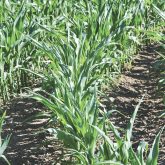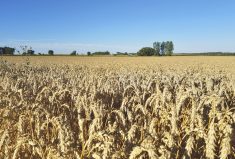If you’re selling bread wheat — Triticum aestivum — there’s a new price signal literally every second as it’s traded on futures markets. If you’re selling its cousin T. durum, finding a fair value is another matter.
There’s no viable futures market for durum wheat, and there can be days or even weeks between trades on the world market, making it subject to sudden price changes. Durum is more like a specialty crop, which means growers need to do their homework.
Canada may be a key player in the world durum market, but it is not the only player and price trends in the Prairies depend on more than just the domestic supply/demand numbers.
Read Also

Producers aren’t panicking over tariffs and trade threats
The influence of tariff and trade uncertainity on farm business decisions.
Statistics Canada estimates that farmers planted 6.1 million acres of durum in 2016, the largest acreage in more than a decade. The official production estimate of 6.8 million tonnes will likely be revised lower in subsequent reports due to the poor harvest, but supplies should still be above the four to five million tonnes grown in recent years.
Canadian domestic durum usage typically comes in under one million tonnes, which means world exports account for the bulk of the price direction. Italy, the birthplace of pasta, is usually the largest single buyer. North African countries, especially Morocco and Algeria, are also big customers, using durum for couscous, a staple food in that area. Those countries grow their own durum as well, so their purchases (and the resulting price in Canada) will also depend on local production in that key demand region.
As on the Prairies, where the crop is concentrated in the traditionally drier areas, a relatively small change in rainfall can mean a large change in the North African crop, and a sudden change in demand.
That’s only reflected in cash values. ICE Futures Canada maintains a durum futures contract in name, although volumes are non-existent and provide little if any price discovery. Movement in the U.S. wheat futures can provide some direction, but the underlying durum fundamentals are different than those at play in the broader wheat markets.

Long gone are the days when the Canadian Wheat Board was the only game in town, but the now rebranded G3 Canada still publishes Pool Return Outlooks with commentary that provides a glimpse at where the company sees durum heading.
PDQ (pdqinfo.ca) provides daily price updates on durum, which can be a good indicator of the day-to-day trend. However, the PDQ numbers cover a wide range of delivery points, and a call to the local elevator is necessary for more detailed price opportunities.
U.S. elevator information is more readily available online, making those markets an important factor for the Canadian farmer to keep an eye on. However, foreign exchange and localized supply/demand issues come to play as well.
Marketing the 2016-17 crop
Every crop year is different, and 2016-17 presents its own challenges for marketing durum. A big issue this year will be quality, with high vomitoxin levels in Canada’s harvest limiting the potential demand channels for a large portion of the crop.
Jerry Klassen, manager of Canadian operations with Swiss-based GAP SA Grains and Products in Winnipeg, trades Canadian durum to Europe. He said any durum with over two parts per million of vomitoxin will need to move to feed channels, with samples of over 1.75 parts per million also facing restricted demand.
Farmers “will need to sell their durum into the feed market over the next four months. That’s when there is seasonal demand for feed,” said Klassen, adding “there are no other options.”
While Canada’s feed grain supplies are burdensome, and feed durum prices will be cheap, Klassen stressed that blending should not take place under any circumstances. Rather, he recommended that farmers get rid of their high-vomi durum for whatever they can get, as storing it is not a good option.
“When you have vomitoxin at that level, you cannot blend it,” said Klassen. “All they are doing is causing a headache for the end-user.” He said blending high-vomi durum runs the risk of a sample coming in above the tolerance, which can result in the rejection of an entire cargo.
European customers will accept durum with vomitoxin levels under 1.75 parts per million, while the cutoff is under two parts per million for all other destinations. Klassen said the best marketing strategy would be to “sell at regular increments throughout the year.”
Canada’s quality problems have given the durum market some strength, but U.S. growers had a relatively good-quality crop. As a result, the large premiums that that may have been seen in previous years for high-quality durum are not available.
In addition, Klassen said the top-end market is already saturated, with high-quality buyers Japan, Switzerland and the U.S. already well supplied for what they need.
“The world market has adjusted for the Canadian quality… You won’t see much price strength beyond what we’ve seen right now,” said Klassen.
Holding durum in an attempt to see better prices is a gamble unlikely to pay off. The European new crop harvest gets underway in May, while Mexico will also be harvesting its durum crop at that time. End-users will be turning their attention to the new-crop supplies in April, limiting the market for Canadian durum.
The Port of Thunder Bay also closed down in December, which means any business will be redirected through the West Coast. With fewer shipping lanes running, the interior bids typically widen during that period as well.
















